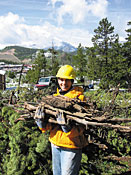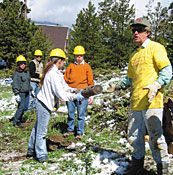|
|
by Tom Valtin
 Colorado is ground zero for the forest fire maelstrom. Colorado Rep. Scott McInnis says his so-called Healthy Forests Restoration Act, which passed the House of Representatives in May, will reduce wildfire risks. Deb Robison, Sierra Club organizer in Boulder, says the McInnis bill allows for logging projects deep in the backcountry in the name of fuel reduction, but does little to protect homes and communities. And to raise awareness about that difference, Robison and 56 other volunteers, including Sierra Club members, cleared brush and slash around nine homes in Silverthorne, Colorado, in a high-wildfire-risk area abutting the White River National Forest. Colorado is ground zero for the forest fire maelstrom. Colorado Rep. Scott McInnis says his so-called Healthy Forests Restoration Act, which passed the House of Representatives in May, will reduce wildfire risks. Deb Robison, Sierra Club organizer in Boulder, says the McInnis bill allows for logging projects deep in the backcountry in the name of fuel reduction, but does little to protect homes and communities. And to raise awareness about that difference, Robison and 56 other volunteers, including Sierra Club members, cleared brush and slash around nine homes in Silverthorne, Colorado, in a high-wildfire-risk area abutting the White River National Forest.
Robison coordinated the June event with Summit County Fire Mitigation Officer Patti Maguire to demonstrate the benefits of the Sierra Club-supported Community Protection Plan for safeguarding homes and communities against wildfires. The Club plan emphasizes brush clearing and "firewise" protections in a 500-yard buffer zone surrounding homes and other structures and calls for grants for states and communities for fuel reduction not just on federal holdings, but on private, state, and tribal lands, which comprise 85 percent of the forested land near vulnerable communities.
Scientists say creating these zones is the best protection against wildfires because it knocks the flames down to a manageable size before they hit homes and other buildings.
Silverthorne homeowners, a Summit County commissioner, and several local businesses, including tree service companies, volunteered their services. Summit County Recycles donated dumpsters and wood chippers to the effort, and volunteers from neighboring towns pitched in. Some, like Tucker Brown, drove over an hour from Denver to lend a hand. "We were interested in the Sierra Club and heard about this," Brown says, "so we decided to come and help."
 Nine homeowners volunteered to have their properties inspected to identify fire hazards such as trees too close to houses and improperly placed propane tanks and stacks of firewood. Treeworks, a contractor from nearby Evergreen, then cut down trees that had been marked, and volunteers collected the slash and mulched it in wood chippers.
One homeowner, Chris Bogott, thanked Robison and said, "This project was so great; I have been telling everyone I talk to this week about it." Nine homeowners volunteered to have their properties inspected to identify fire hazards such as trees too close to houses and improperly placed propane tanks and stacks of firewood. Treeworks, a contractor from nearby Evergreen, then cut down trees that had been marked, and volunteers collected the slash and mulched it in wood chippers.
One homeowner, Chris Bogott, thanked Robison and said, "This project was so great; I have been telling everyone I talk to this week about it."
"This project shows what can happen when fire departments, local government, and community environmental groups get together to work on a project," says Gary Lindstrom, Summit County Commissioner and conservation chair for the Club's Blue River Group.
The timber lobby and its allies in Washington charge that wildfire risks have been exacerbated in recent years by environmental safeguards. But current conditions, says Sean Cosgrove, a Sierra Club forest policy specialist in Washington, D.C., are the result of a severe multi-year drought, decades of extensive logging, and a century of overly aggressive fire suppression that has left many of our national forests cluttered with small, highly flammable brush. Fire is a natural part of the forest and has a role to play in any forest's life cycle by clearing out brush and restoring nutrients to the soil.
"If the Forest Service focuses resources and personnel in Community Protection Zones and gives this mission top priority, communities can be made safer, quickly," says Cosgrove. "This approach is fiscally sound, is backed by irrefutable science, helps people immediately, and has wide public support."
The Senate is expected to take up its own forest legislation sometime this summer. Please write your senators and urge them to oppose any bill that would increase logging in our national forests in areas far from communities. Urge them to seek positive solutions that will help protect homes and lives by focusing fuel reduction measures on the Community Protection Zone, the first 500 yards out from homes and communities.
Up to Top
|